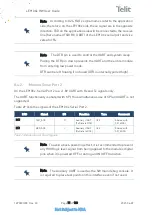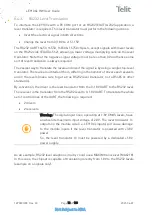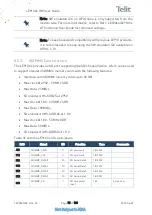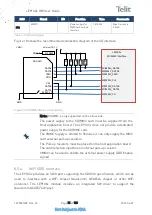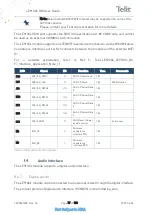
LE910Cx HW User Guide
1VV0301298 Rev. 33
Page 62 of 128
2021-06-29
Not Subject to NDA
•
If EM-noisy devices are present on the PCB hosting the LE910Cx, such as fast
switching ICs, take care to shield them with a metal frame cover.
•
If EM-noisy devices are not present around the line, geometries like Micro strip or
Grounded Coplanar Waveguide are preferred because they typically ensure less
attenuation if compared to a Strip line of the same length.
GSM/WCDMA/LTE Antenna – Installation Guidelines
•
Install the antenna in a location with access to the network radio signal.
•
The antenna must be installed such that it provides a separation distance of at
least 20 cm from all people and must not be co-located or operating in conjunction
with any other antenna or transmitter.
•
The antenna must not be installed inside metal cases.
•
The antenna must be installed according to the antenna manufacturer’s
instructions.
Antenna Diversity Requirements
This product includes an input for a second Rx antenna to improve radio sensitivity. The
function is called Antenna Diversity.
Item
Value
Frequency
range
The customer must use the most suitable antenna bandwidth to cover the frequency bands
provided by the network operator and supported by the OEM while using the Telit module.
The bands supported by each variant of the LE910Cx module family are provided in Section
Impedance
50
Ω
VSWR
recommended
≤
2:1 (limit to fulfill all regulatory requirements)
Table 23: Antenna Diversity Requirements
Since there is no antenna connector on the LE910Cx module, the antenna must be
connected to the LE910Cx antenna pad by means of a transmission line implemented on
the PCB.
If the antenna is not connected directly to the LE910Cx (F1) antenna pad, a PCB line is
required to connect to it or to its connector.
The second Rx antenna must not be placed in the immediate vicinity of the main antenna.
To improve diversity gain and isolation and to reduce mutual interaction, the two
antennas should be placed at the as far apart as possible, taking into consideration the
available space within the application.
























